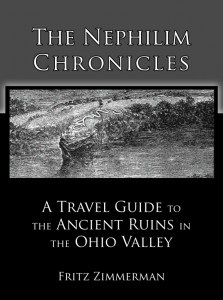Excavation of the Circleville, Ohio Adena, Burial Mound
Near the center of the round fort was a tumulus of earth about 10 feet in height and several rods in diameter at its base. On its eastern side, and extending 6 rods from it, was a semicircular pavement composed of pebbles such as are now found in the bed of the Scioto River, from whence they appear to have been brought. The summit of this tumulus was nearly 30 feet in diameter, and there was a raised way to it, leading from the east, like a modern turnpike. The summit was level. The outline of the semicircular pavement and the walk is still discernible. The earth composing this mound was entirely removed several years since. The writer was present at its removal and carefully examined the contents. It contained—
1st. Two human skeletons, lying on what had been the original surface of the earth.
2d. A great quantity of arrow-heads, some of which were so large as to induce a belief that they were used as spear-heads.
3d. The handle either of a small sword or a huge knife, made of an elk’s horn. Around the end where the blade had been inserted was a ferule of silver, which, though black, was not much injured by time. Though the handle showed the hole where the blade had been inserted, yet no iron was found, but an oxyde remained of similar shape and size.
4th. Charcoal and wood ashes on which these articles lay, which were surrounded by several bricks very well burnt. The skeleton appeared to have been burned in a large and very hot fire, which had almost consumed the bones of the deceased. This skeleton was deposited a little to the south of the center of the tumulus; and about 20 feet to the north of it was another, with which were—
5th. A large mirrour about 3 feet in breadth and 1½ inches in thickness. This mirrour was of isinglass (mica membranacea), and on it—
6th. A plate of iron which had become an oxyde, but before it was disturbed by the spade resembled a plate of cast iron. The mirrour answered the purpose very well for which it was intended. This skeleton had also been burned like the former, and lay on charcoal and a considerable quantity of wood ashes. A part of the mirrour is in my possession, as well as a piece of brick taken from the spot at the time. The knife or sword handle was sent to Mr. Peal’s Museum, at Philadelphia.
To the southwest of this tumulus, about 40 rods from it, is another, more than 90 feet in height, which is shown on the plate representing these works. It stands on a large hill, which appears to be artificial. This must have been the common cemetery, as it contains an immense number of human skeletons of all sizes and ages. The skeletons are laid horizontally, with their heads generally towards the center and the feet towards the outside of the tumulus. A considerable part of this work still stands uninjured, except by time. In it have been found, besides these skeletons, stone axes and knives, and several ornaments, with holes through them, by means of which, with a cord passing through these perforations, they could be worn by their owners. On the south side of this tumulus, and not far from it, was a semicircular fosse, which, when I first saw it, was 6 feet deep. On opening it was discovered at the bottom a great quantity of human bones, which I am inclined to believe were the remains of those who had been slain in some great and destructive battle: first, because they belonged to persons who had attained their full size, whereas in the mound adjoining were found the skeletons of persons of all ages; and, secondly, they were here in the utmost confusion, as if buried in a hurry. May we not conjecture that they belonged to the people who resided in the town, and who were victorious in the engagement? Otherwise they would not have been thus honorably buried in the common cemetery.


























